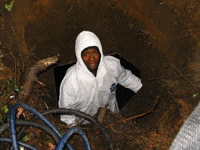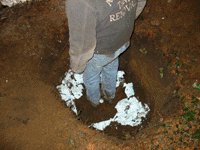TANK ABANDONMENT
Tank Abandonment is an alternative to Tank Removal and should be done only when Removal is not practical or possible. Removing a tank is usually less expensive and allows the area where the tank resided to be completely clean from contaminants. Abandonment requires the tank to be emptied, cleaned, and soil samples taken from underneath the tank. The basic steps involved are listed below:
1) Oil is removed from the tank
2) Expose the top of the tank by hand
3) Cut a 2 ft x 4 ft hole in the top of the tank
4) All sludge and residual oil is removed from the tank
5) Tank is pressure washed
6) A small hole (1″ x 1″) is cut in the bottom of the tank
7) Soil samples are taken and tested
8) Tank is then filled with an inert material such as sand
9) Fill and vent pipes are removed
10) The metal cut from the top of the tank in step 3 is replaced
11) The hole is back filled and graded to cover the tank
12) We will issue a letter report summarizing your project and soil results.
Our professionally trained personnel have the experience and the resources to safely provide and economically manage all of your environmental service needs. Absolute Tank Removal will solve your environmental problems with the right people and the right expertise to provide you with the most cost effective solution.
TANK ABANDONMENT PROCEDURES

Steps 1, 2, & 3
We will remove any oil from the tank and then expose the top of the tank by hand. We will then cut the top of the tank open to produce a hole approximately 2’ wide by 4’ long to allow access by our trained technicians

Steps 4 & 5
We will vacuum the tank of any free product as well as vacuum out sludge and residual oil. The interior of your tank will be pressure washed to remove all of the tank contents.

Step 6
Confined Space Trained Technicians (CFR 291910.120 Certified) will enter the tank and cut out a 1 in. x 1 in. hole in the bottom of the tank for extraction of soil samples.

Step 7
A soil sample will be collected from beneath the tank under Chain of Custody protocols and witnessed by local authorities. The soil sample will be analyzed on site using a PetroFlag® soil analysis kit and the original sample will be sent to a state certified lab to confirm our site findings.

Step 8
Providing the soil sample has no evidence of oil impacts, the tank will be filled with an inert material (i.e. foam, sand, or gravel) otherwise the tank may need to be removed. This is the best reason to simply remove the tank in the first place (whenever possible).

Step 9, 10, 11 ,& 12
When the tank is full with inert material, the panel that was cut off earlier will be replaced.
We will backfill over the top of the tank and compact the area to it’s original grade.
We will issue a letter report summarizing the project and soil results.
